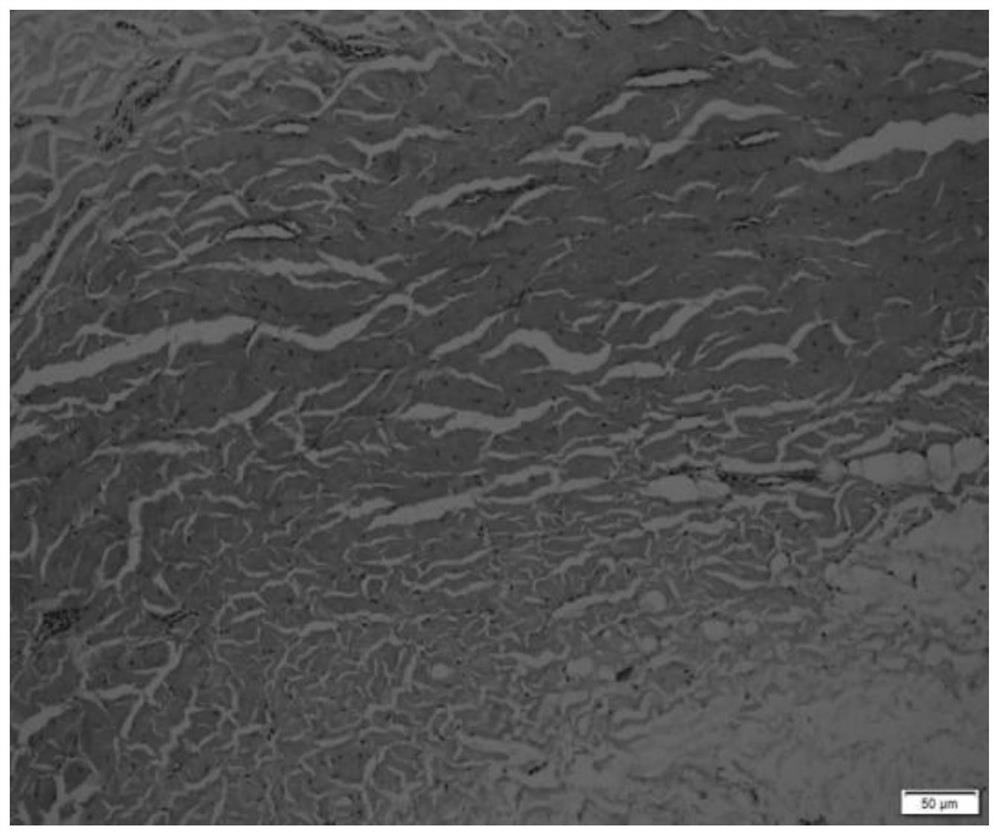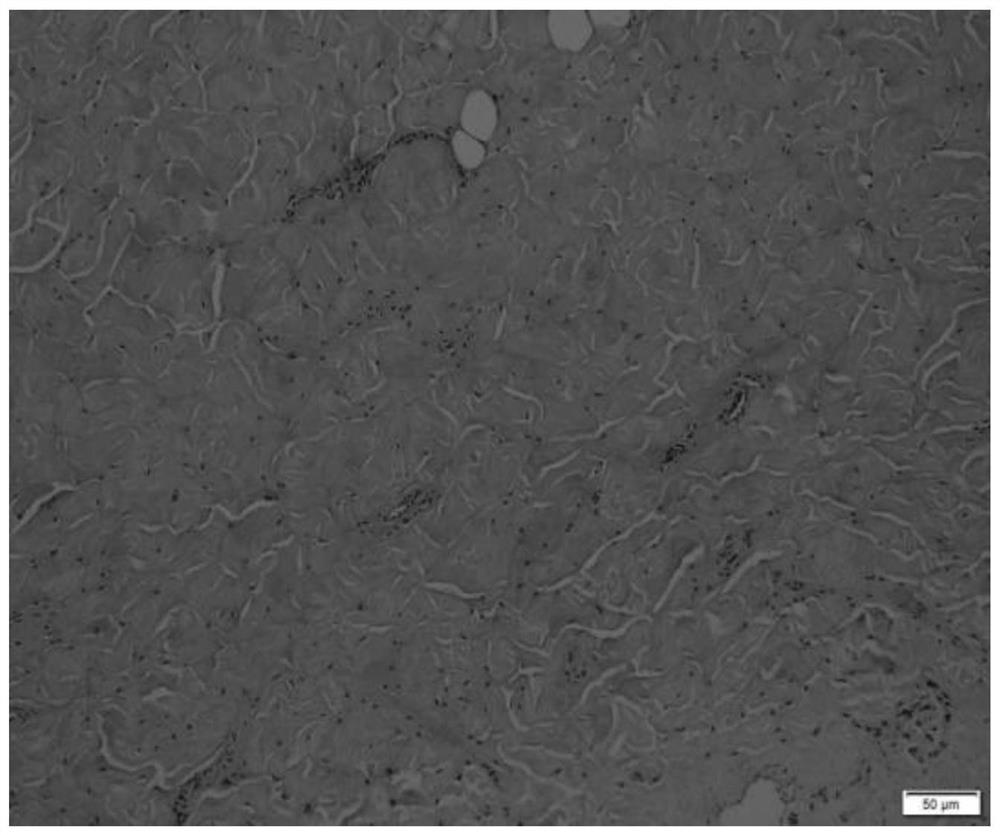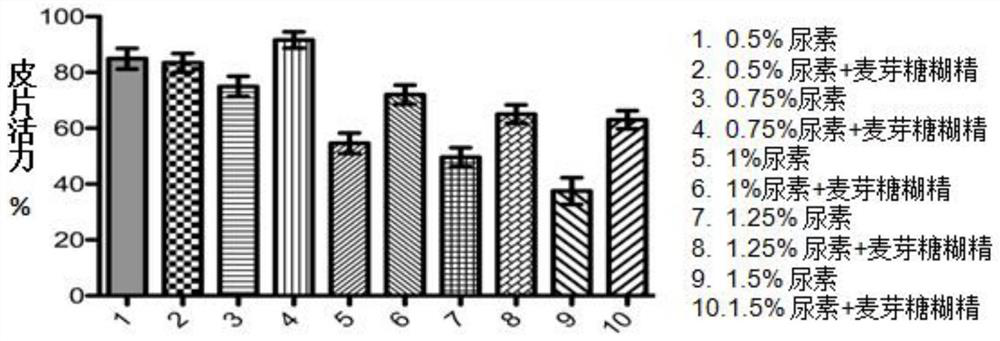A skin cryoprotectant and skin preservation method
A cryogenic and protective agent technology, applied in the field of cryogenic preservation of biological materials, can solve the problems of patient infection risk, difficult quality assurance, component differences, etc., to avoid infection risks, improve success rate, and achieve the effect of small changes in biological properties
- Summary
- Abstract
- Description
- Claims
- Application Information
AI Technical Summary
Problems solved by technology
Method used
Image
Examples
Embodiment 1
[0029] Embodiment 1 preparation cryoprotectant and skin preservation
[0030] Preparation of cryoprotectant: Mix 80ml of RPMI 1640 medium (Hyclone, USA) with 10ml of human serum albumin (BR, China), then slowly add 10ml of dimethyl sulfoxide (Sigma, USA) to prepare the base solution , and then add maltodextrin and urea (10 kinds of cryoprotectants were prepared because of the different final concentrations of maltodextrin and urea, and the final concentrations of maltodextrin and urea in each cryoprotectant are shown in Table 1) , fully dissolved and mixed to prepare a cryoprotectant, and placed in a 4°C refrigerator for pre-cooling.
[0031] Prepare Kreb's Ringer's phosphate buffer: get 11.421g disodium hydrogen phosphate (Sigma, U.S.), 2.26g sodium dihydrogen phosphate (Sigma, U.S.), and dilute to 500ml with distilled water to prepare 0.1M phosphate buffer; 0.9g sodium chloride (Sigma, the U.S.), 1.15g potassium chloride (Sigma, the U.S.), 1.22g calcium chloride (Sigma, the...
experiment example 1
[0040] Experimental Example 1 Histomorphological Observation
[0041] Paraffin sections were made by HE staining method for histomorphological observation.
[0042] After rapid rewarming in a water bath at 42°C, put the pigskin preserved in deep cryogenic temperature (0.75% urea + 15% maltodextrin group) and the pigskin preserved in glycerol in 4% formaldehyde, and fix them overnight in a refrigerator at 4°C. The samples were sent to the Department of Pathology, East District, Shandong Provincial Hospital of Traditional Chinese Medicine (No. 16369, Jingshi Road, Lixia District, Jinan City, Shandong Province) for HE-stained paraffin sections.
[0043] The paraffin sections of the samples were observed and photographed with an optical microscope (Olympus BX53), and the results were as follows: figure 1 and figure 2 shown. Depend on figure 1 and figure 2 It can be seen from the comparison of the morphological results that, compared with the control example, the pigskin tis...
experiment example 2
[0044] Experimental Example 2 Survival rate of pig skin slices after resuscitation
[0045] Use the succinate dehydrogenase assay to detect the survival rate of pig skin slices after resuscitation, the steps are as follows:
[0046] (1) Trim the rewarmed pigskin to a size of about 1cm 2 Two skin slices were taken for each treatment period in each group, and the quality of the skin slices was measured.
[0047] (2) Put 2 pieces of skin into a 5ml syringe (Weigao, China), apply Vaseline on the back of the syringe to seal it, then inhale 1ml of the mixed reaction solution into the syringe, try to remove air bubbles, and place the syringe needle with Rubber stopper seal.
[0048] (3) Place the sealed syringe in a constant temperature incubator (Thermo Fisher, USA) at 37°C and incubate for 60 min, and a red precipitate can be observed on the skin slice.
[0049] (4) After removing the reaction solution, inhale 2ml of ethylene glycol ether into each syringe, and place it at room ...
PUM
 Login to View More
Login to View More Abstract
Description
Claims
Application Information
 Login to View More
Login to View More - R&D
- Intellectual Property
- Life Sciences
- Materials
- Tech Scout
- Unparalleled Data Quality
- Higher Quality Content
- 60% Fewer Hallucinations
Browse by: Latest US Patents, China's latest patents, Technical Efficacy Thesaurus, Application Domain, Technology Topic, Popular Technical Reports.
© 2025 PatSnap. All rights reserved.Legal|Privacy policy|Modern Slavery Act Transparency Statement|Sitemap|About US| Contact US: help@patsnap.com



